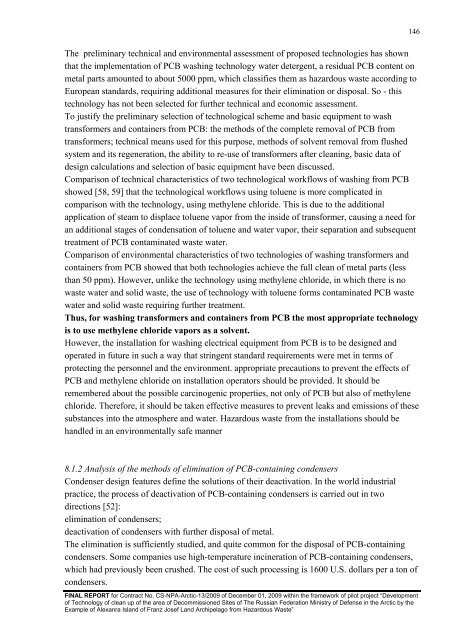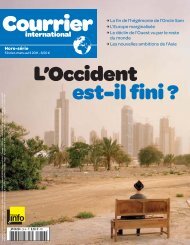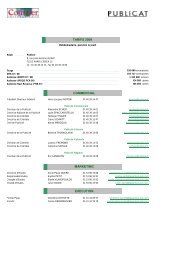2 ОРГАНИЗАЦИЯ И МЕТОДИКА РАБОТ - Courrier international
2 ОРГАНИЗАЦИЯ И МЕТОДИКА РАБОТ - Courrier international
2 ОРГАНИЗАЦИЯ И МЕТОДИКА РАБОТ - Courrier international
You also want an ePaper? Increase the reach of your titles
YUMPU automatically turns print PDFs into web optimized ePapers that Google loves.
The preliminary technical and environmental assessment of proposed technologies has shown<br />
that the implementation of PCB washing technology water detergent, a residual PCB content on<br />
metal parts amounted to about 5000 ppm, which classifies them as hazardous waste according to<br />
European standards, requiring additional measures for their elimination or disposal. So - this<br />
technology has not been selected for further technical and economic assessment.<br />
To justify the preliminary selection of technological scheme and basic equipment to wash<br />
transformers and containers from PCB: the methods of the complete removal of PCB from<br />
transformers; technical means used for this purpose, methods of solvent removal from flushed<br />
system and its regeneration, the ability to re-use of transformers after cleaning, basic data of<br />
design calculations and selection of basic equipment have been discussed.<br />
Comparison of technical characteristics of two technological workflows of washing from PCB<br />
showed [58, 59] that the technological workflows using toluene is more complicated in<br />
comparison with the technology, using methylene chloride. This is due to the additional<br />
application of steam to displace toluene vapor from the inside of transformer, causing a need for<br />
an additional stages of condensation of toluene and water vapor, their separation and subsequent<br />
treatment of PCB contaminated waste water.<br />
Comparison of environmental characteristics of two technologies of washing transformers and<br />
containers from PCB showed that both technologies achieve the full clean of metal parts (less<br />
than 50 ppm). However, unlike the technology using methylene chloride, in which there is no<br />
waste water and solid waste, the use of technology with toluene forms contaminated PCB waste<br />
water and solid waste requiring further treatment.<br />
Thus, for washing transformers and containers from PCB the most appropriate technology<br />
is to use methylene chloride vapors as a solvent.<br />
However, the installation for washing electrical equipment from PCB is to be designed and<br />
operated in future in such a way that stringent standard requirements were met in terms of<br />
protecting the personnel and the environment. appropriate precautions to prevent the effects of<br />
PCB and methylene chloride on installation operators should be provided. It should be<br />
remembered about the possible carcinogenic properties, not only of PCB but also of methylene<br />
chloride. Therefore, it should be taken effective measures to prevent leaks and emissions of these<br />
substances into the atmosphere and water. Hazardous waste from the installations should be<br />
handled in an environmentally safe manner<br />
8.1.2 Analysis of the methods of elimination of PCB-containing condensers<br />
Condenser design features define the solutions of their deactivation. In the world industrial<br />
practice, the process of deactivation of PCB-containing condensers is carried out in two<br />
directions [52]:<br />
elimination of condensers;<br />
deactivation of condensers with further disposal of metal.<br />
The elimination is sufficiently studied, and quite common for the disposal of PCB-containing<br />
condensers. Some companies use high-temperature incineration of PCB-containing condensers,<br />
which had previously been crushed. The cost of such processing is 1600 U.S. dollars per a ton of<br />
condensers.<br />
FINAL REPORT for Contract No. CS-NPA-Arctic-13/2009 of December 01, 2009 within the framework of pilot project Development<br />
of Technology of clean up of the area of Decommissioned Sites of The Russian Federation Ministry of Defense in the Arctic by the<br />
Example of Alexanra Island of Franz Josef Land Archipelago from Hazardous Waste<br />
146








